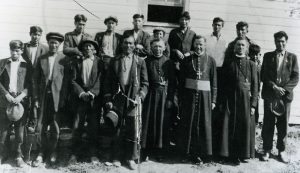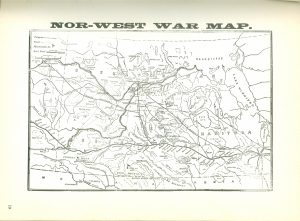Biographical Timeline | Leadership Qualities | Sixties Scoop Settlement | References
APTN National News. “David Chartrand discusses Metis people being left out of 60s Scoop settlement.” YouTube video, 7:00. Posted Oct 11, 2017. https://www.youtube.com/watch?v=d7kodYDDovI.
Barkwell, Lawrence J. “Louis Riel Petitions for a Reserve in Montana (1880).” Scribd (insert year) https://www.scribd.com/doc/35106203/Louis-Riel-Petitions-for-a-Reserve-in-Montana-1880
Boyden, Joseph. Louis Riel and Gabriel Dumont. Toronto: Penguin Canada, 2013.
Boyer, Kurt. “1885 – Aftermath.” 1885 – Aftermath | Our Legacy. Accessed December 7, 2017. http://digital.scaa.sk.ca/ourlegacy/exhibit_aftermath
Findlay, Heather, Anna Sajecki, and Melissa Bremer. “The North West Resistance – 1885.” The Riel Rebellion: Background. Goldi Productions Ltd., 2007. http://firstpeoplesofcanada.com/fp_metis/fp_metis_background.html.
Flanagan, Thomas. “Manitoba Historical Society Keeping History Alive for over 138 Years.” Manitoba History: Louis Riel’s Land Claims, April 11, 2010. http://www.mhs.mb.ca/docs/mb_history/21/riellandclaims.shtml.
Foster, Keith, and Nelle Oosterom. “Shifting Riel-Ity: The 1885 North-West Rebellion.” Canada’s History – Canada’s History. Canada’s History, February 2013. http://www.canadashistory.ca/Explore/First-Nations,-Inuit-Metis/Shifting-Riel-ity-The-1885-North-West-Rebellion.
Goldsborough, Gordon. “Manitoba Historical Society: Keeping History Alive for over 138 Years.” Memorable Manitobans: Louis Riel (1844-1885). Manitoba Historical Society, October 24, 2017. http://www.mhs.mb.ca/docs/people/riel_l.shtml.
Linder, Douglas O. “Message to Congress from President Harrison.” Famous Trials http://www.famous-trials.com/louisriel/840-presidentmessage
“Métis celebrate historic Supreme Court land ruling.” CBC News. Accessed Dec 5, 2017. http://www.cbc.ca/news/politics/métis-celebrate-historic-supreme-court-land-ruling-1.1377827.
“Métis groups split over proposal to exonerate Louis Riel.” The Toronto Star. Accessed Dec 6, 2017. https://www.thestar.com/news/canada/2017/04/03/mtis-groups-split-over-proposal-to-exonerate-louis-riel.html.
Mika, Helma and Nick. The Riel Rebellion: 1885. Belleville, Ont.: Mika Silk Screening, 1972
Mulvaney, Charles Pelham. The History of the North-west Rebellion of 1885. Toronto: A. H Hovey & Co, 1886
“Priests and Group of Metis at Beauval, SK.” Saskatchewan Archives Board. Accessed December 8, 2017. http://digital.scaa.sk.ca/ourlegacy/solr?query=ID:25918&start=0&rows=10&mode=results
Riel, Louis. The collected writings of Louis Riel. Edmonton: University of Alberta Press, 1985.
West, Linda, and Bill Dunn. “Northwest Rebellion 1885.” Canada A Country by Consent: Native Treaties 1871-1897: Northwest Rebellion 1885. West/Dunn Productions, 1993. http://www.canadahistoryproject.ca/1871-97/1871-06-nw-rebellion-1885.html.
“Who Are the Métis.” Métis Nation of Ontario. Métis Nation of Ontario, 2017. http://www.metisnation.org/culture-heritage/louis-riel/part-3/



